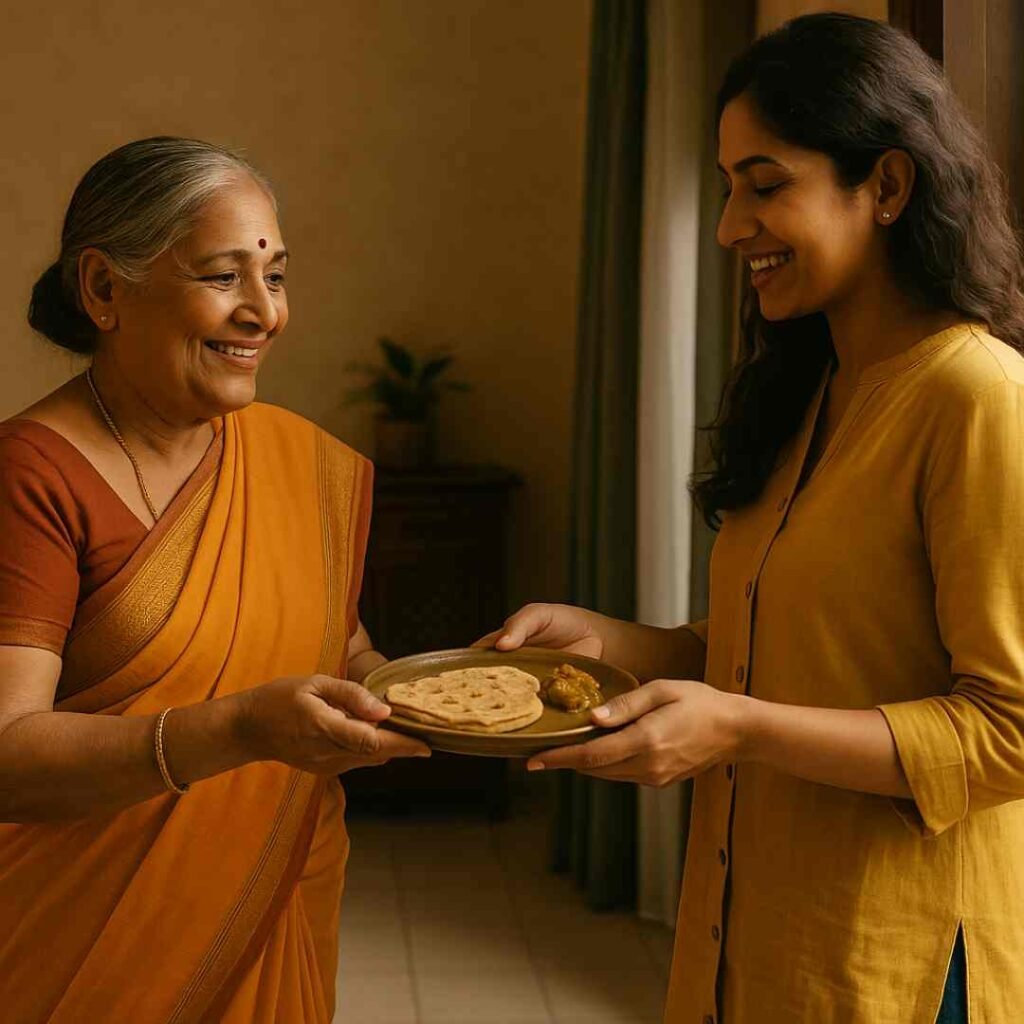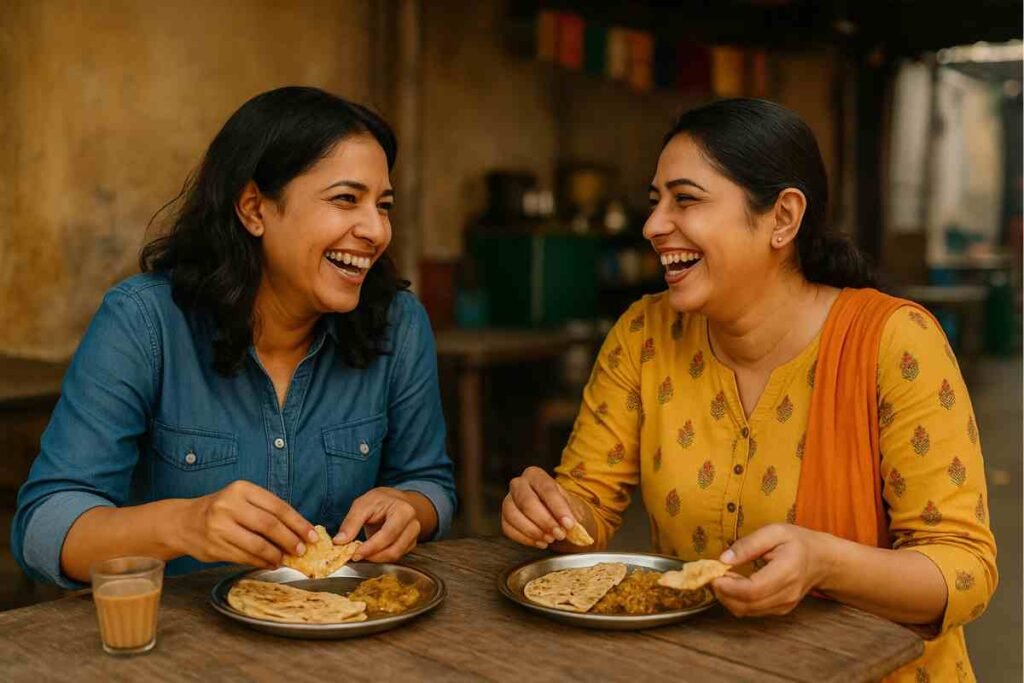Table of Contents
Forget flowery poetry, grand romantic gestures, or even a simple “How are you?”. If you want to tap into the very soul of Indian affection, to understand the deepest currents of care that run through our families and friendships, you need to listen for one simple, profound question: “Have you eaten?” (or its many linguistic variants: “Khaana kha liya?”, “Saaptingala?”, “Oota Aaita,” and “Jevan jhaala ka?”).
On the surface, it’s a straightforward inquiry about nourishment. But anyone who has grown up in an Indian household knows it’s rarely just about the food. It’s a hug in the form of a question. It’s a verbal thermometer checking on your well-being. It’s the universal, all-purpose, undeniable Indian language of love, concern, and care.
When your mother calls and her first question isn’t about your career or your love life, but whether you’ve had lunch; when a friend you haven’t seen in months greets you with “Let’s eat first, then we’ll talk”; when an elderly relative insists on feeding you even when you’re bursting at the seams – this isn’t just about hospitality.
This is a complex, beautiful social ritual, a unique expression of care through food that shapes our relationships in a way found almost nowhere else. So, let’s pull up a chair and unpack the rich, layered meaning behind India’s most important question.
More Than a Meal: Cracking the Code of Concern

When an Indian asks if you’ve eaten, they are often asking a dozen other questions simultaneously, all wrapped up in the comforting guise of food.
- “Are you okay? Really okay?” In a culture where directly expressing emotional vulnerability can sometimes be difficult, enquiring about food is a safe, indirect way to check in on someone’s overall state. A missed meal might imply stress, sadness, illness, or being overworked. Answering “yes” is a reassurance that, at a basic level, you are functioning and taking care of yourself.
- “Are you feeling stressed or overworked?” The image of someone being “too busy to eat” is a common trope. The question is a gentle nudge, a reminder to pause and prioritise your well-being. It’s your mom’s way of saying, “Don’t let that deadline consume you.”
- “Do you feel welcomed and cared for in my home?” As a host, ensuring your guest is well-fed is the absolute, paramount duty. It’s the cornerstone of Indian hospitality (Atithi Devo Bhava – The Guest is God). Asking if they’ve eaten is the first step in a campaign of feeding that will likely end with the guest being lovingly force-fed “just one more” roti. Accepting food is accepting their care.
- “I want to reconnect with you.” For friends and relatives meeting after a long time, the act of sharing a meal is the primary vehicle for reconnection. “Let’s grab a bite” isn’t just a suggestion; it’s the main event. The conversation happens around the food. Breaking bread (or naan) together reaffirms the bond.
- “I love you and I am thinking of you.” Ultimately, this is the core message. Providing or ensuring nourishment is one of the most fundamental ways to express love and care, a primal instinct that has been elevated to a high art form in Indian culture.

The Food-First Protocol: How It Shapes Our Relationships
This “food as care” language creates distinctive patterns in how we interact and build relationships.
- The Parental Radar: For Indian parents, their child’s dietary intake is a lifelong obsession, regardless of whether the “child” is 6 or 60. A phone call that doesn’t start with a food inquiry is almost suspicious. It’s their primary metric for your happiness and health. This can be endearing, occasionally smothering, but always, always rooted in deep affection.
- Hospitality as an Olympic Sport: When you visit an Indian home, declining food can be perceived as almost rude, a rejection of the host’s care. The script is predictable:
- Host: “Have some tea!”
- Guest: “No, no, I just had some.”
- Host: “Just a little. And some biscuits. I’ve already put the water on to boil.”
- 10 minutes later, you are drinking tea and eating biscuits.
This isn’t about being pushy; it’s about an overwhelming desire to provide comfort and care. The guest’s role is to protest politely before graciously accepting. It’s a well-rehearsed social dance.
- Friendship Forged in Flavours: Friendships are often deepened and maintained over shared meals – from college canteen maggi to late-night biryani runs. “Let’s catch up” almost always means “Let’s eat together.” It’s the default social setting.
- Problem-Solving Through Provisions: Feeling down? A friend might show up with your favourite comfort food. Celebrating a success? Distribute sweets! Food is used to mark occasions, soothe sorrows, and share joy. It’s the universal solution.
Why is This Expression So Uniquely Intense in India?
While offering food is a sign of hospitality worldwide, the Indian approach is distinctive in its intensity, its frequency, and its deep integration into the language of everyday emotion.
- A History of Scarcity, A Culture of Plenty: In a land that has historically faced famine and scarcity, ensuring that your loved ones and guests are full is a profound expression of prosperity and well-being. Providing food generously is a sign that you are blessed, and you wish to share that blessing.
- The Concept of “Annapurna”: Food is not just sustenance; it’s considered sacred. Annapurna is the Hindu goddess of food and nourishment. Wasting food is frowned upon, and providing it is seen as a virtuous act. This imbues the act of feeding someone with a spiritual significance.
- The Centrality of the Family Meal: The shared family meal is a cornerstone of Indian life, a time for connection and communication. This idea extends outwards – to treat a guest like family means to feed them as you would your own.
- Indirect Emotional Expression: As mentioned, in a culture that sometimes prizes stoicism, food becomes a powerful and acceptable medium for expressing emotions that are harder to say out loud – love, worry, pride, and concern.
More Than a Question, It’s an Embrace
So, the next time an Indian mother, friend, or relative looks you in the eye and asks, “Have you eaten?”, resist the urge to give a simple “yes” or “no.” Understand that you are being offered more than just a potential meal. You are being asked if you are okay, if you are happy, and if you are cared for. You are being told, in the most Indian way possible, that you matter.
It’s a simple question with a universe of love packed into it. And the only truly correct response, whether you’re hungry or not, is to feel the warmth of that care, smile, and maybe… just maybe, have a small snack. It would be rude not to.
What does the question “Have you eaten?” mean to you? How has this “food as care” language played out in your own life and relationships? Share your stories and experiences in the comments below!
Did this article warm your heart (and make you a little hungry)? Share it on your favourite social media platform and let’s celebrate this beautiful Indian expression of love!
Keep coming back to IndiLogs for more nourishing insights into the Indian way of life.